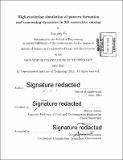High-resolution simulation of pattern formation and coarsening dynamics in 3D convective mixing
Author(s)
Fu, Xiaojing, S.M. Massachusetts Institute of Technology
DownloadFull printable version (4.328Mb)
Other Contributors
Massachusetts Institute of Technology. Computation for Design and Optimization Program.
Advisor
Ruben Juanes.
Terms of use
Metadata
Show full item recordAbstract
Geologic C0₂ sequestration is considered a promising tool to reduce anthropogenic C0₂ emissions while allowing continued use of fossil fuels for the current time. The process entails capturing C0₂ at point sources such as coal-fired power plants, and injecting it in its supercritical state into deep saline aquifers for long-term storage. Upon injection, C0₂ partially dissolves in groundwater to form an aqueous solution that is denser than groundwater. The local increase in density triggers a gravitational instability at the boundary layer that further develops into columnar C0₂-rich plumes that sink away. This mechanism, also known as convective mixing, greatly accelerates the dissolution rate of C0₂ into water and provides secure storage of C0₂ underground. Understanding convective mixing in the context of C0₂ sequestration is essential for the design of injection and monitoring strategies that prevent leakage of C0₂ back into the atmosphere. While current studies have elucidated various aspects of this phenomenon in 2D, little is known about this process in 3D. In this thesis we investigate the pattern-formation aspects of convective mixing during geological C0₂ sequestration by means of high-resolution three-dimensional simulation. We find that the C0₂ concentration field self-organizes as a cellular network structure in the diffusive boundary layer right beneath the top boundary. By studying the statistics of the cellular network, we identify various regimes of finger coarsening over time, the existence of a nonequilibrium stationary state, and an universal scaling of 3D convective mixing. We explore the correlation between the observed network pattern and the 3D flow structure predicted by hydrodynamics stability theory.
Description
Thesis: S.M., Massachusetts Institute of Technology, School of Engineering, Center for Computational Engineering, Computation for Design and Optimization Program, 2015. Cataloged from PDF version of thesis. Includes bibliographical references (pages 45-47).
Date issued
2015Department
Massachusetts Institute of Technology. Computation for Design and Optimization ProgramPublisher
Massachusetts Institute of Technology
Keywords
Computation for Design and Optimization Program.